Cobrowse
Overview
Cobrowse gives agents the ability to help Web Chat customers navigate issues by viewing their screen or taking remote control of their Chat page.
Using Cobrowse
Initiating Cobrowse
The Request Cobrowse button can be found to the right of the conversation message form in the agent messaging interface for Web Chat conversations. When the button is clicked a confirmation dialog displays:
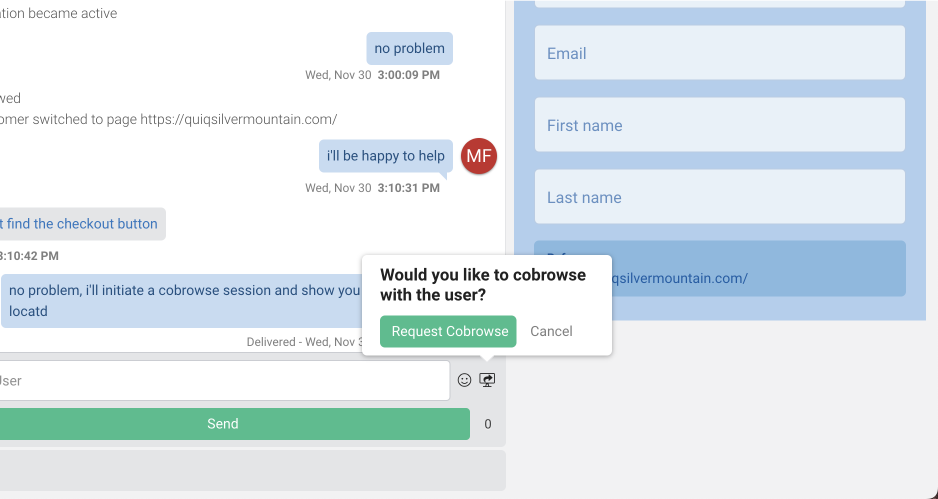
Enabling Cobrowse
If you don't see the Cobrowse option, contact Quiq Support to have it enabled.
By default, Cobrowse will be enabled for all agents, if you'd like to limit Cobrowse to a specific set of agents, please work with Quiq Support.
When a new Chat conversation comes in for an agent, the Request Cobrowse button is disabled until the agent sends an initial message.
When an agent selects Request Cobrowse, an agent requested a cobrowse session event displays in the agent’s conversation view if Conversation Details is enabled, and a separate browser tab opens for the agent that will display the Cobrowse session:
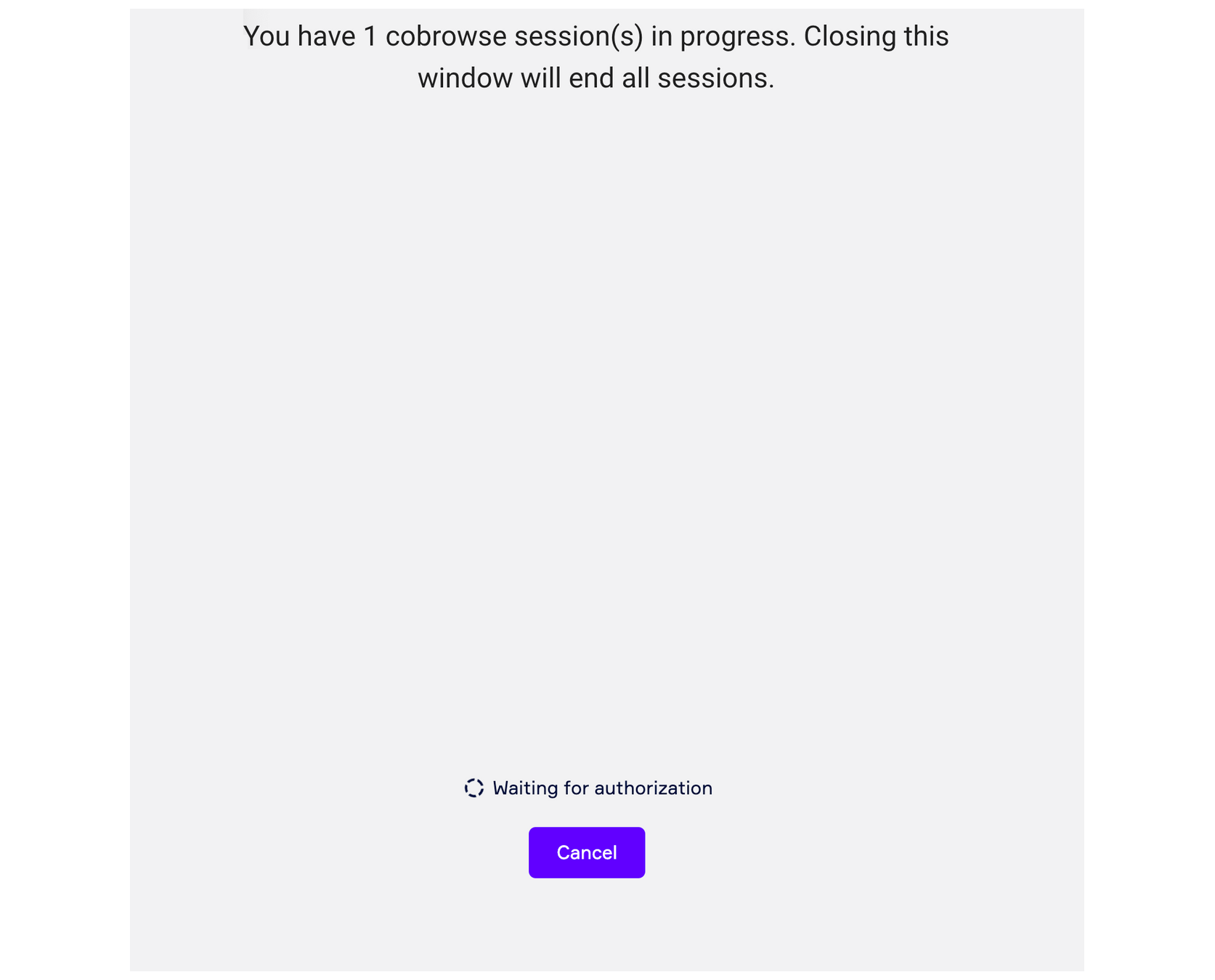
Permissions Request
After an agent requests Cobrowse, the user will see a Permissions Request dialog in their Chat window:
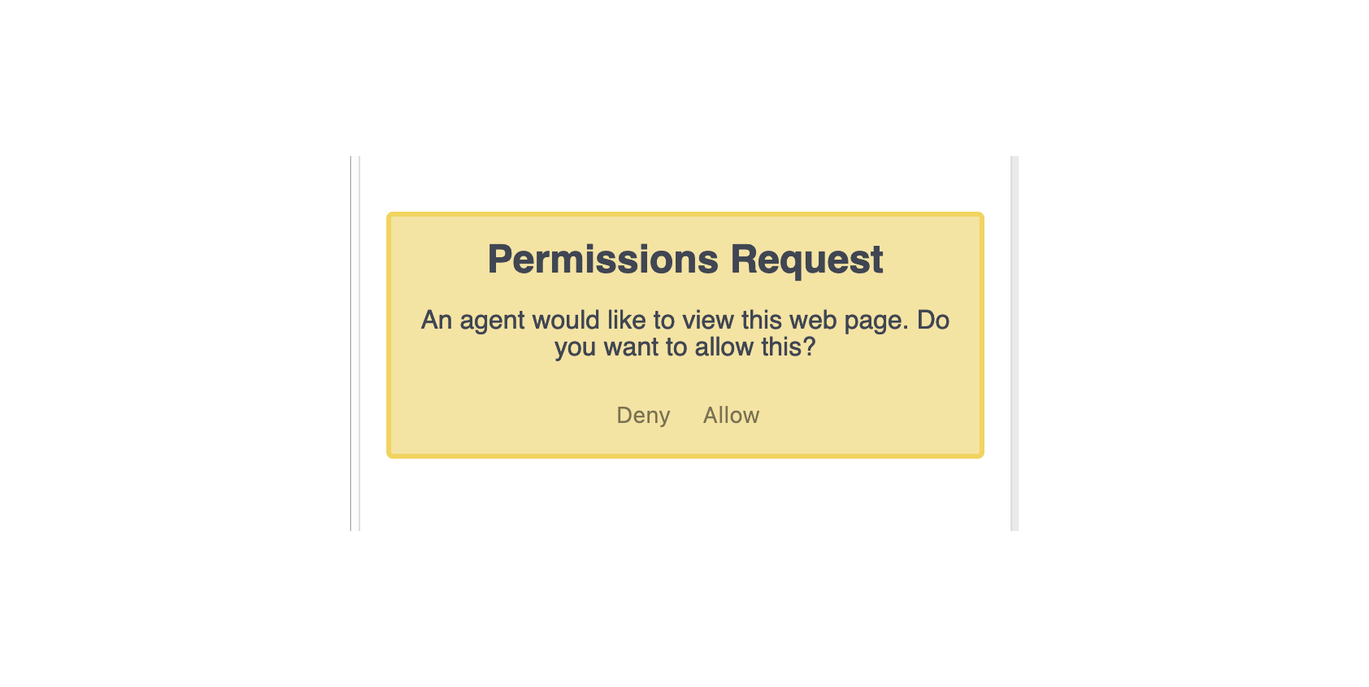
If the customer selects Deny in the Permissions Request dialog, that dialog closes, the Cobrowse session is canceled, and a customer denied permission to cobrowse event displays in the agent's conversation view.
If the customer selects Allow in the Permissions Request dialog, the dialog closes, a Cobrowse session is started, and a customer granted permission to cobrowse event displays in the agent's conversation view.
If the agent requests to Cobrowse while the user has the Chat window minimized, the request will come through as an Agent requesting cobrowse notification blurb that displays with the Chat button (if the Widget associated with the Chat page is configured to display notification blurbs), and when the user then opens the Chat window the Permissions Request dialog displays.
Cobrowse Session
During the Cobrowse session, a banner displays at the top of the user's Chat page and Chat window letting them know they're in an active Cobrowse session, with an End Cobrowse button users can use to end the session at any time:
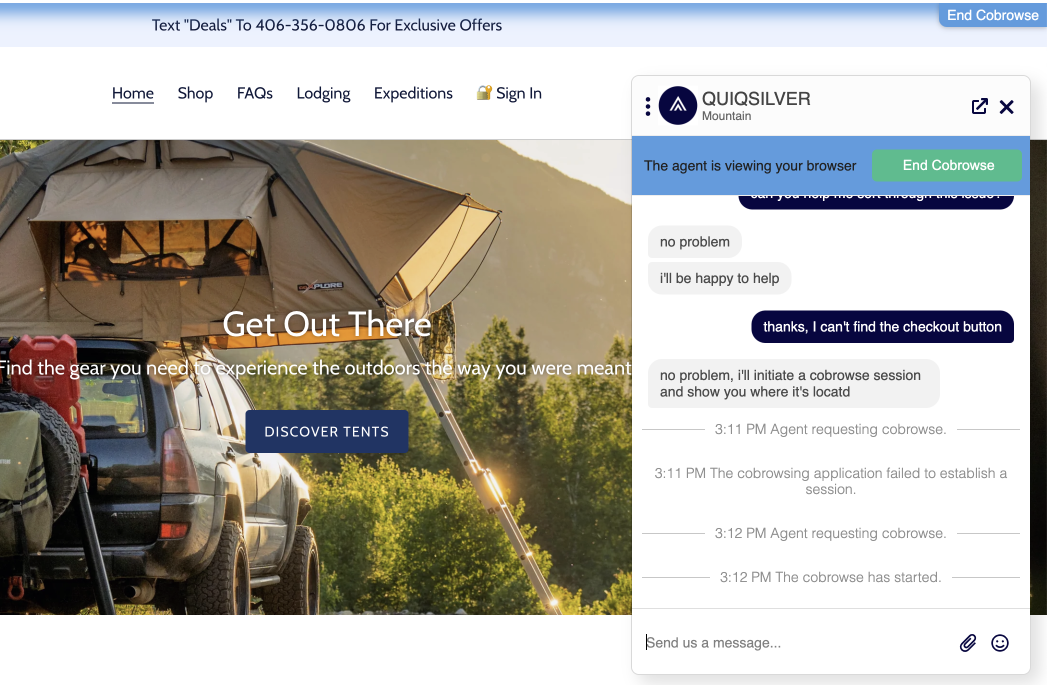
The agent Cobrowse page loads with the Cobrowse control buttons and displays the customer's browser window (including the Chat window):
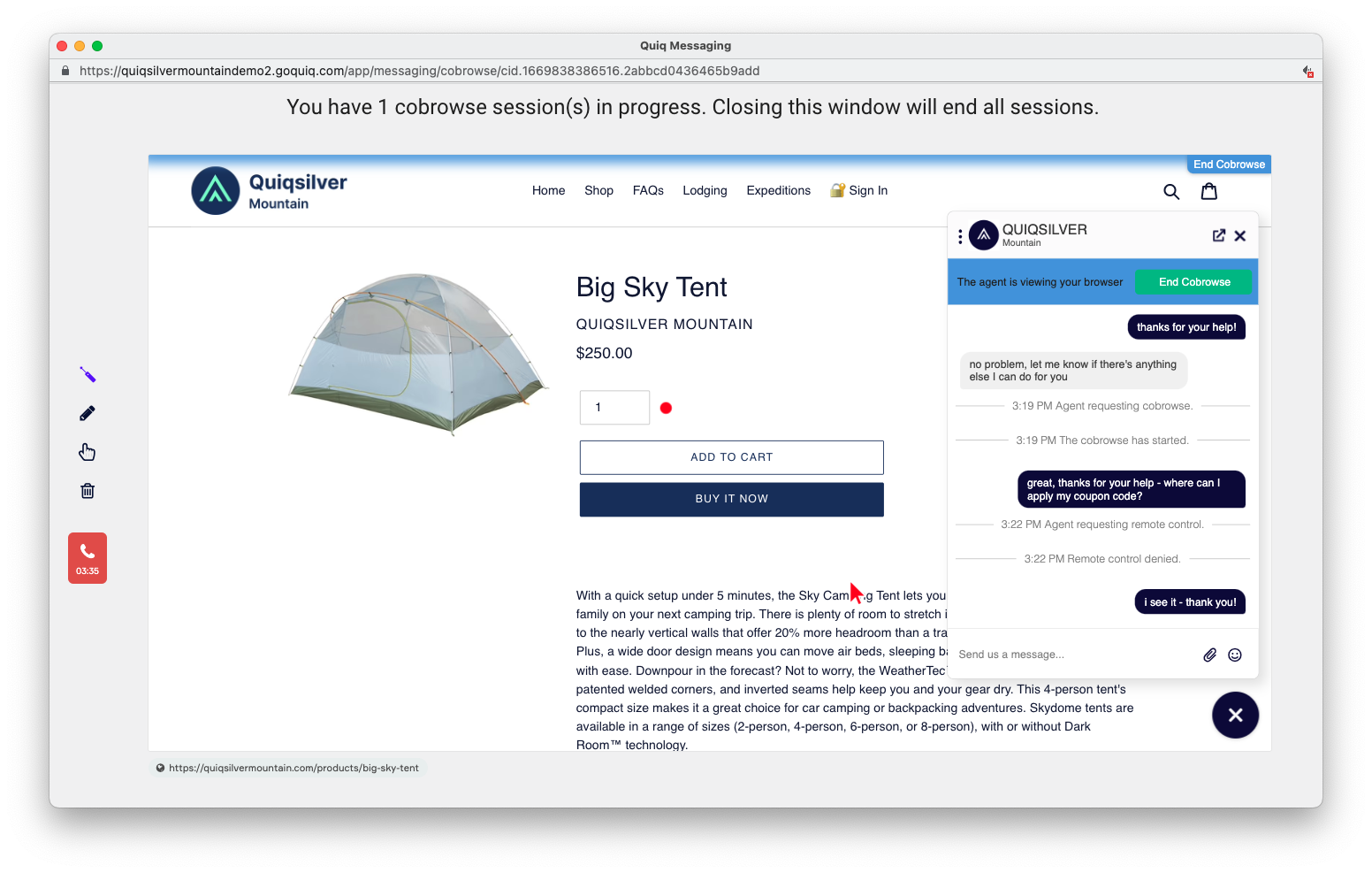
Switching Between Conversations
If the agent has an active Cobrowse session, and a different conversation is selected where Cobrowse isn’t available, the text Cobrowse is not available for the current conversation displays in the Cobrowse page.
This applies to the cases where the agent hasn't sent a response message yet for the selected Chat conversation, or if a non-Chat conversation is selected.
Agents can have multiple Cobrowse sessions active at the same time, however they will only be able to see the Cobrowse session of the conversation they currently have selected.
Focusing Cobrowse
During an active Cobrowse session, agents can select the Focus Cobrowse button to refocus the Cobrowse window if they lose track of it:
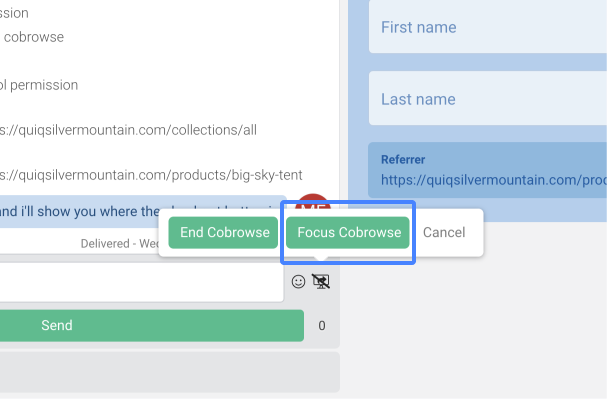
Ending Cobrowse Sessions
Agent Initiated
An active Cobrowse session can be ended by the agent clicking the End Cobrowse button in the conversation view, or clicking the End button in the agent Cobrowse page:
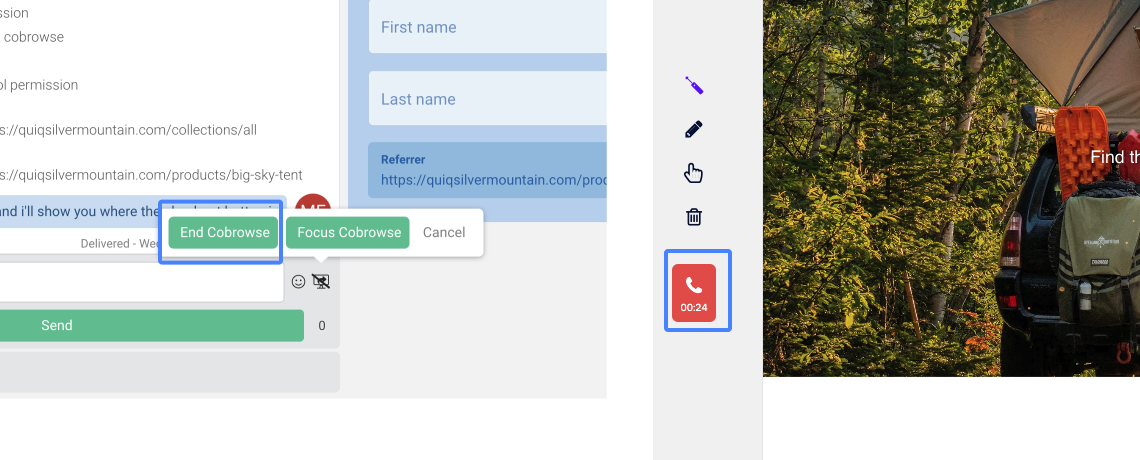
User Initiated
The user can end a session by clicking the End Cobrowse button in the banner in their Chat window, or in the top right of the Chat page in their browser window:
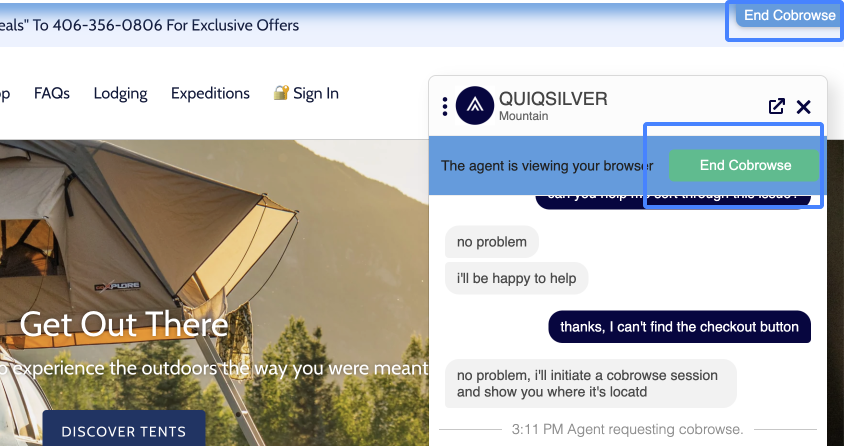
Logging Out
Active Cobrowse sessions are ended if the agent logs out of Quiq while they still own the conversations associated with the active sessions.
Closing Conversations
An active Cobrowse session will automatically end when the conversation ends.
Inactive Conversations
When a conversation with an active Cobrowse session becomes Inactive, the Cobrowse session ends, and Cobrowse cannot be reinitiated until the conversation becomes active again.
Transferring or Requeuing Conversations
When a conversation with an active Cobrowse session is Transferred, the Cobrowse sessions ends. The new agent can start a new Cobrowse session for the conversation at this point if necessary.
When a conversation with an active Cobrowse session is manually Queued, or is taken away from the agent and Queued, the Cobrowse session ends.
When a conversation with an active Cobrowse session is manually taken away from an agent by an Admin or Manager, the Cobrowse session ends.
Cobrowse Tools
The agent has a number of tools available to them while in an active Cobrowse session:

1. Laser Pointer
Allows agents to highlight sections of the Chat page in the user's browser window.
2. Drawing Tool
Allows agents to draw on the Chat page in the user's browser window.
3. Remote Control
When Remote Control is enabled, agents can perform any action on the user's Web Chat page.
The availability of the Remote Control tool is optional, let Quiq Support know if it should be available for agents during the Cobrowse setup for your Quiq site.
Initiating Remote Control
When the agent selects the Remote Control button during a Cobrowse session, a Permissions Request dialog displays in the user's Chat window:
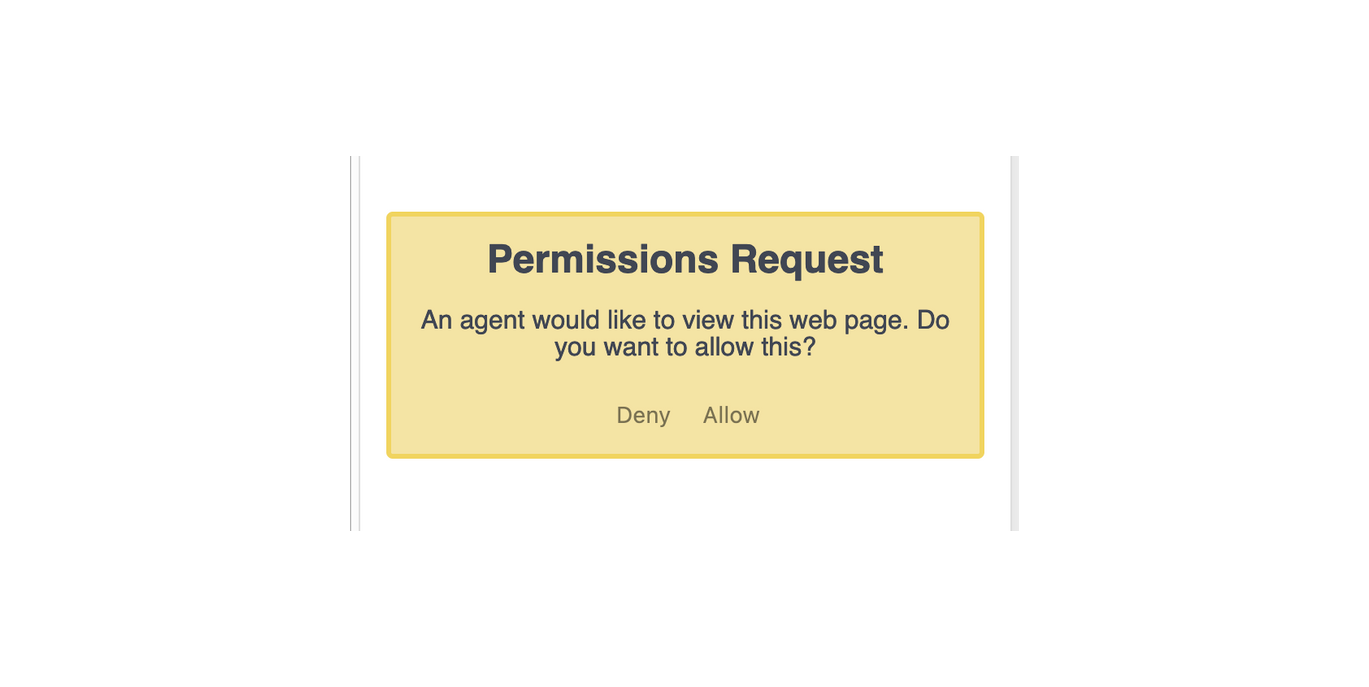
If the user selects Deny in the Permissions Request dialog, that dialog closes, the Remote Control request is canceled, and a customer denied remote control permission event displays in the agent's conversation view.
If the user selects Allow for the Remote Control request, a customer granted remote control permission event displays in the agent's conversation view, and remote control starts so that the agent can perform actions in the Chat page in the customer's browser window.
The user will see a Remote Control banner & event appear in their Chat conversation:
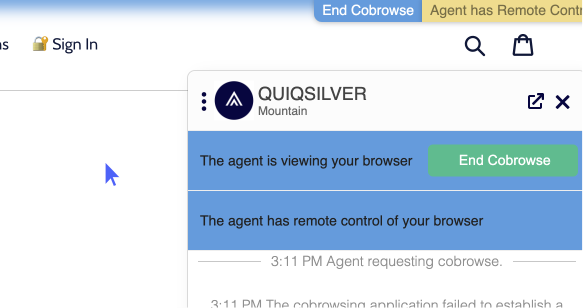
If the agent requests Remote Control while the user has the Chat window minimized, the request will come through as an Agent requesting remote control notification blurb that displays with the Chat button (if the Widget associated with the Chat page is configured to display notification blurbs), and when the user then opens the Chat window the Permissions Request dialog displays.
Ending Remote Control
Currently there isn’t a way for the customer to end Remote Control - they’d need to completely end the Cobrowse session. The agent also can’t choose to end Remote Control only - they’d also need to end the entire Cobrowse session.
4. Clear Annotations
Removes anything drawn on the end user's browser window during the session.
5. End Cobrowse
This will end the active Cobrowse session.
6. Full Device Mode
The availability of the Full Device tool is optional, let Quiq Support know if it should be available for agents during the Cobrowse setup for your Quiq site.
Initiating Full Device Mode
When the agent enables the FULL DEVICE toggle button during a Cobrowse session, a Permissions Request dialog displays in the user's Chat window:
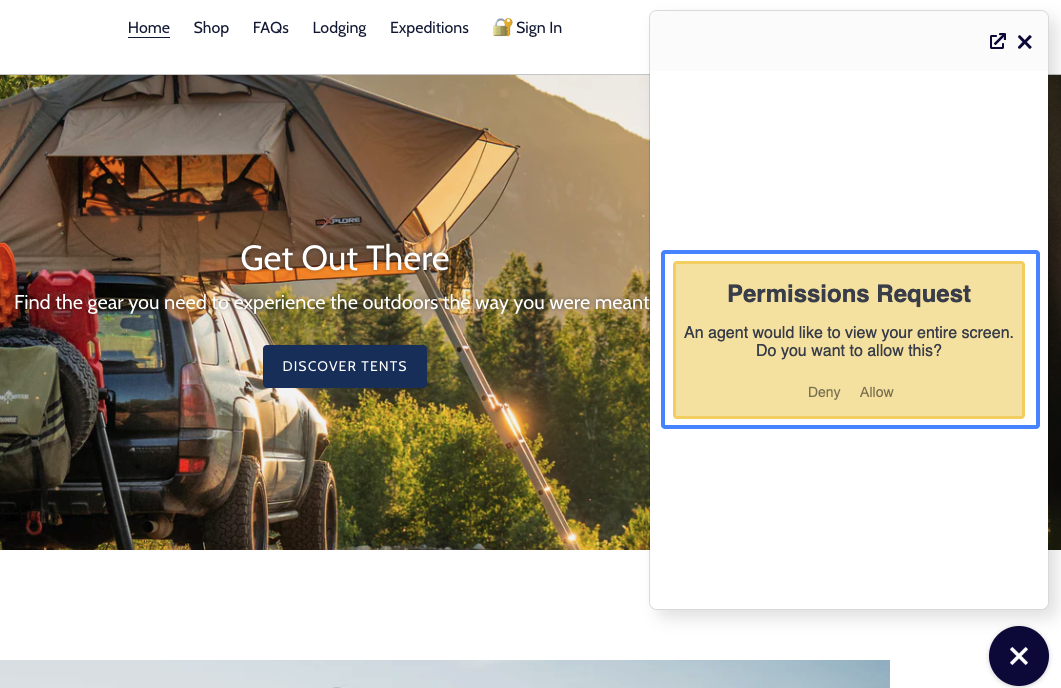
If the user selects Deny in the Permissions Request dialog, that dialog closes, the Full Device mode request is canceled, and a customer (or their device) denied extended screen access permission event displays in the agent's conversation view.
If the user selects Allow for the Full Device mode request, a customer granted extended screen access permission event displays in the agent's conversation view, and a browser-specific dialog displays at the top of the users's Chat page where they can choose which part of their screen to share. Depending on the user's browser, they may have the ability to choose to share a specific browser tab, window, or their entire screen:
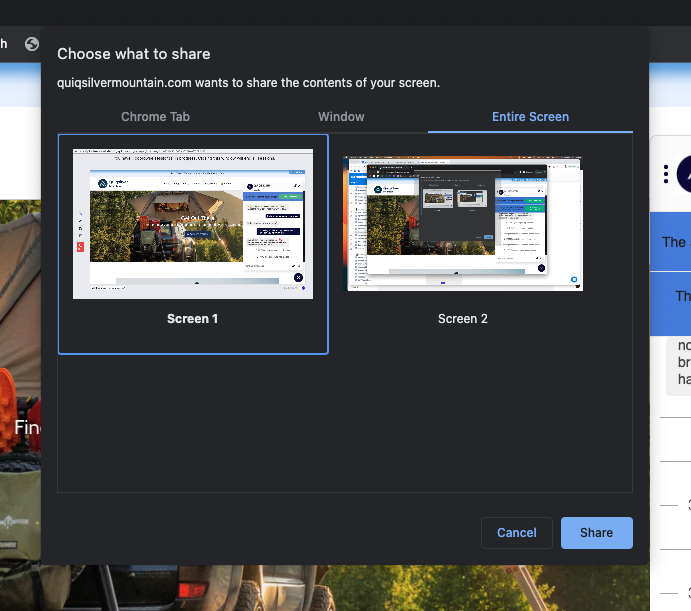
Once the user selects what they want the agent to be able to view, the agent Cobrowse page displays the parts of the user's screen that were shared.
The user will see a Stop Sharing Window/Tab button appear in the Cobrowse banners in their Chat page and Chat window:
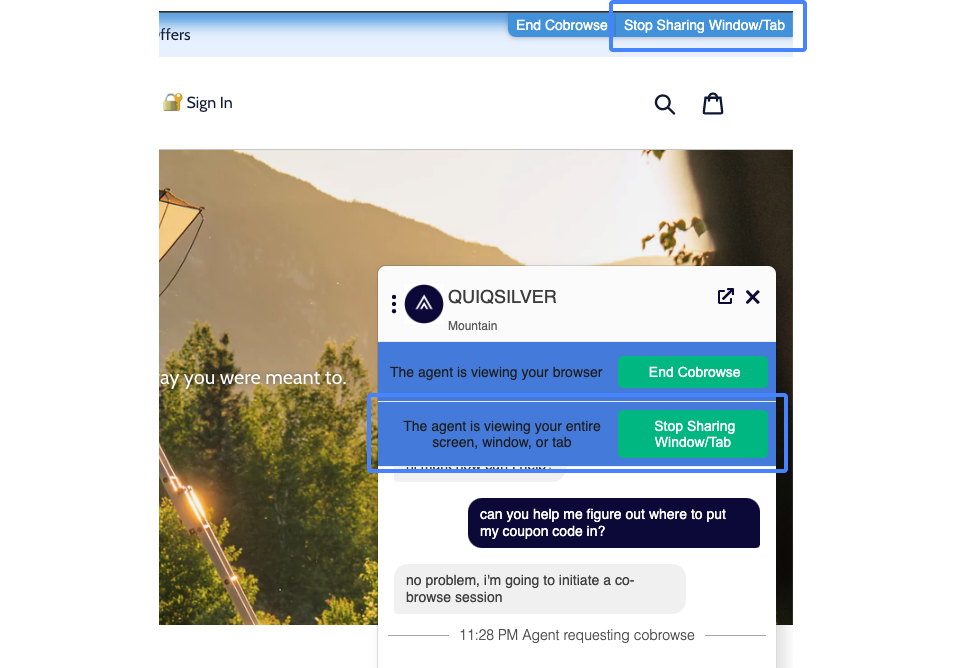
Full Device Mode Tools
The Laser Pointer, Drawing Tool, Clear Annotations and Remote Control options are not supported while Full Device mode is active, so those tools are disabled in the agent Cobrowse page while the session is in Full Device mode.
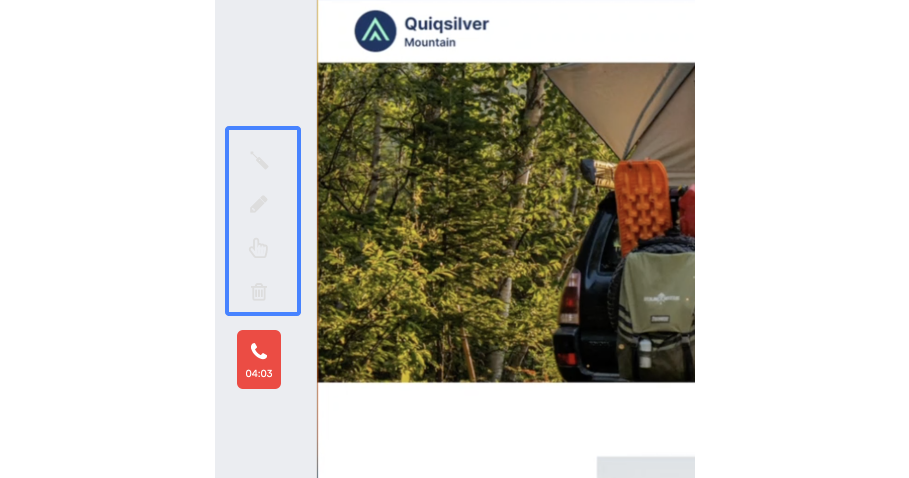
The disabled tool bar in Full Device mode.
If the agent requests Full Device mode while the user has the Chat window minimized, the request will come through as an Agent requesting extended screen access notification blurb that displays with the Chat button (if the Widget associated with the Chat page is configured to display notification blurbs), and when the user then opens the Chat window the Permissions Request dialog displays.
Ending Full Device Mode
When Full Device mode is ended, the agent Cobrowse page will reload so that it goes back to only displaying the user's browser window for the Chat page.
The agent can end Full Device mode by disabling the FULL DEVICE toggle button in the agent Cobrowse page:
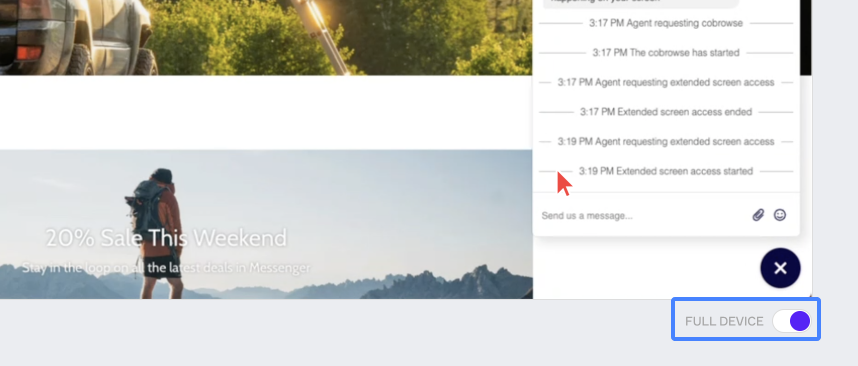
The user can end Full Device mode by selecting the Stop Sharing Window/Tab button in the banner in their Chat window, or in the top right of the Chat page in their browser window:
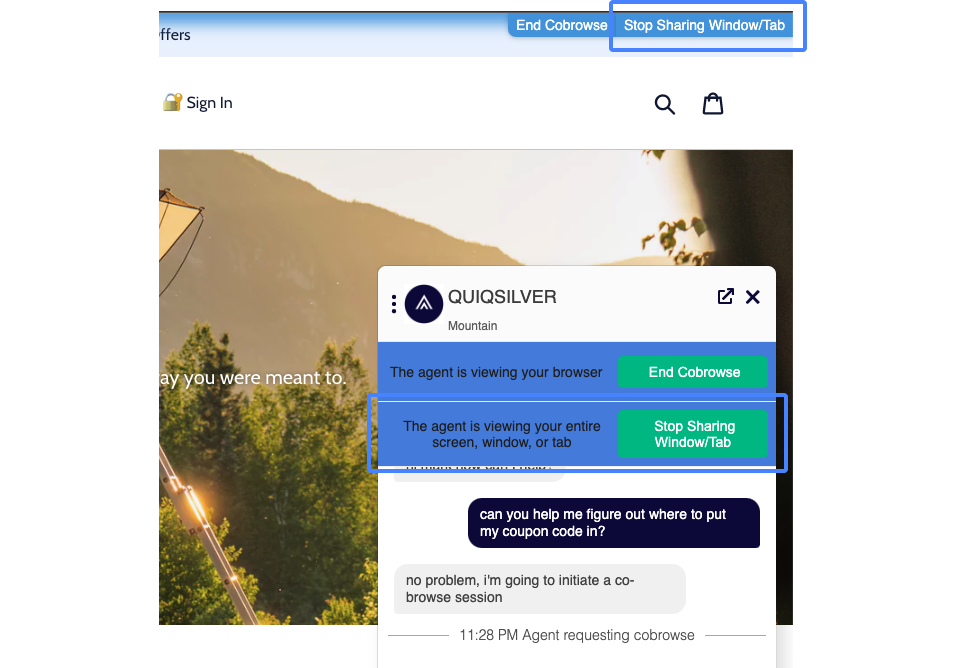
Limitations
Limitations
Cobrowse is not supported for non-Web Chat channels (SMS, Messenger, etc.)
Cobrowse only applies to pages on your website that have Quiq Web Chat.
Cobrowse is not supported in the Oracle Service Cloud .NET client.
Cobrowse is supported in Conversation Starter Web Chat but not in legacy Web Chat. If your organization would benefit from using Cobrowse and you're currently using legacy Web Chat, please contact Quiq Support to discuss migrating to Conversation Starter Web Chat.
Restricting Sensitive Information
If a page contains sensitive information that an agent should not be able to view, this information can be blocked in one of the following ways:
Block the entire page
Within Quiq a page can be blacklisted to prevent agents from viewing that page during Cobrowse. Quiq Support will maintain the Cobrowse blacklist for a site (in the initial release).
Block a specific section in the page
A portion of a page can be blocked from agent view during Cobrowse by adding the CSS class cobrowse-redacted. Contact Quiq Support for help if you need to do this but are unable to make these changes on your website.
<div class="cobrowse-redacted">Will not be seen by an agent in a Cobrowse session</div>
Cobrowse Events
Once Cobrowse is enabled, you can create analytics components, like Funnels and cards that help measure different events. Below you'll find a list of some of the events that can be tracked out of the box with Cobrowse.
| Event | Definition |
|---|---|
| Cobrowse session denied | Occurs when a customer rejects a Cobrowse session request |
| Cobrowse session error | Occurs when a Cobrowse session error occurs |
| Cobrowse session granted | Occurs when a customer accepts a Cobrowse session invitation |
| Cobrowse session requested | Occurs when an agent sends a Cobrowse session invitation to a customer |
| Cobrowse session revoked | Occurs when a Cobrowse session ends |
Updated 1 day ago
